Brief

At a Glance
- Customers expect a seamless experience across channels, and delivering on that expectation is a key priority for retailers of all types.
- Research by Bain and Aptos shows that retailers that invest in the tech to deliver a seamless experience see significantly higher profitability and sales growth than their peers—but few companies have a clear roadmap.
- In addition to essential back-end technologies, most retailers believe that in-store technology is critical, although most feel their physical stores are not yet ready to deliver.
- Retailers are more likely to succeed when they secure alignment across the organization and use data analytics to understand customer preferences across physical and digital channels.
Retail customers increasingly expect a seamless experience across physical and digital channels. New research by Bain and retail technology provider Aptos shows that 99% of retailers believe a well-executed unified commerce strategy has an impact on overall profitability (73% cite a large to significant impact) and 100% of retailers see an impact on overall sales revenue (with 76% citing a large to significant impact). Nearly 100% of retailers also believe that a well-executed unified commerce strategy has an impact on increased purchase sizes, reduced operating costs, preserved margins in the last mile, higher customer conversion rates, the ability to attract new customers, higher customer loyalty, improved cross-channel customer experience, improved employee experience, more reliable inventory management, more reliable supply chain operations, increased upselling and cross-selling, and reduced lost sales.
Written in collaboration with
Written in collaboration with

These retail leaders invest in developing a deep understanding of their customers and their shopping habits and preferences. They focus on the complete tech stack, from customer experience to data systems, connecting the customer’s profile, history, rewards, and incentives across physical and digital channels to create a single view of the customer and ultimately activate a truly unified commerce experience. This enables them to deliver a tailored experience online or in physical stores. Importantly, these leaders also work to align the entire organization, especially leaders in the business and technology functions, on the value of creating this seamless experience, and they foster cross-organizational efforts to make it happen.
"The customer doesn’t think of having a unified experience across retail and online as a nice-to-have or a feature; they just expect it."
This complete view of the customer is a key feature of what we call “unified commerce”—our term for deploying retail technology to provide a seamless customer experience across all sales channels and customer touchpoints. Unified commerce comprises the technology and experience across the entire stack; as retail tech leaders focus on the back-end connectivity of sales and customer touchpoint systems, operational and marketing leaders focus on the seamless experience on the front end for customers. Both elements are necessary to achieve business goals.
"Unified basically means you have one single real-time inventory visibility across all the different nodes of your network. You have multiple distribution centers, you have multiple fulfillment centers, but basically, it's one unified view of the inventory, and then you can really sell the product from any channel or return from any channel."
This type of approach has become table stakes for most retailers, who want to provide their customers with a wide range of omnichannel capabilities:
- buy online and pick up in store;
- redeem online promo codes in a store;
- shop in a store and deliver to the home, or pick up in a neighboring store;
- have visibility into the store’s inventory before visiting the store;
- make returns easily, whether the item was bought in a store or online; and
- pay with options like Klarna, PayPal, or Venmo, either in store or online.
But about half (45%) of retailers lack a strategic roadmap to guide their investments in unified commerce and ensure that their organization is creating value from the changes implemented.
To understand what unified commerce means for retailers, as well as what capabilities are required to deliver a superior shopping experience across channels and the challenges faced in doing so, Bain and Aptos surveyed more than 300 retail executives in the US, the UK, and Canada who are responsible for unified commerce investments at their organizations. Retail segments surveyed include apparel stores, department and general merchandise stores, electronics, home furnishing, luxury retail, sports and recreation, beauty, footwear, home and hardware stores, accessories, and travel and hospitality. Surveyed retailers’ annual revenue is no less than $150 million. Most respondents cited earnings between $150 million and $50 billion in annual revenue.
Three out of four executives said they consider investing in unified commerce important or very important. Adjacent tech priorities necessary to enabling unified commerce were also ranked as a high priority by retail leaders surveyed, including cloud migration and related cloud infrastructure, e-commerce platforms, supply chain technology solutions, and CRM applications. Almost as many said that they expect those unified commerce investments, when combined with a well-executed strategy, to raise profitability, improve customer and employee experience, and help with inventory management (see Figure 1). Nearly all agreed unified commerce also increases purchase sizes, reduces operating costs, preserves margins in the last mile, boosts conversion rates, attracts new customers and raises customer loyalty, fosters greater reliability in supply chain operations, increases upselling and cross-selling, and reduces lost sales.
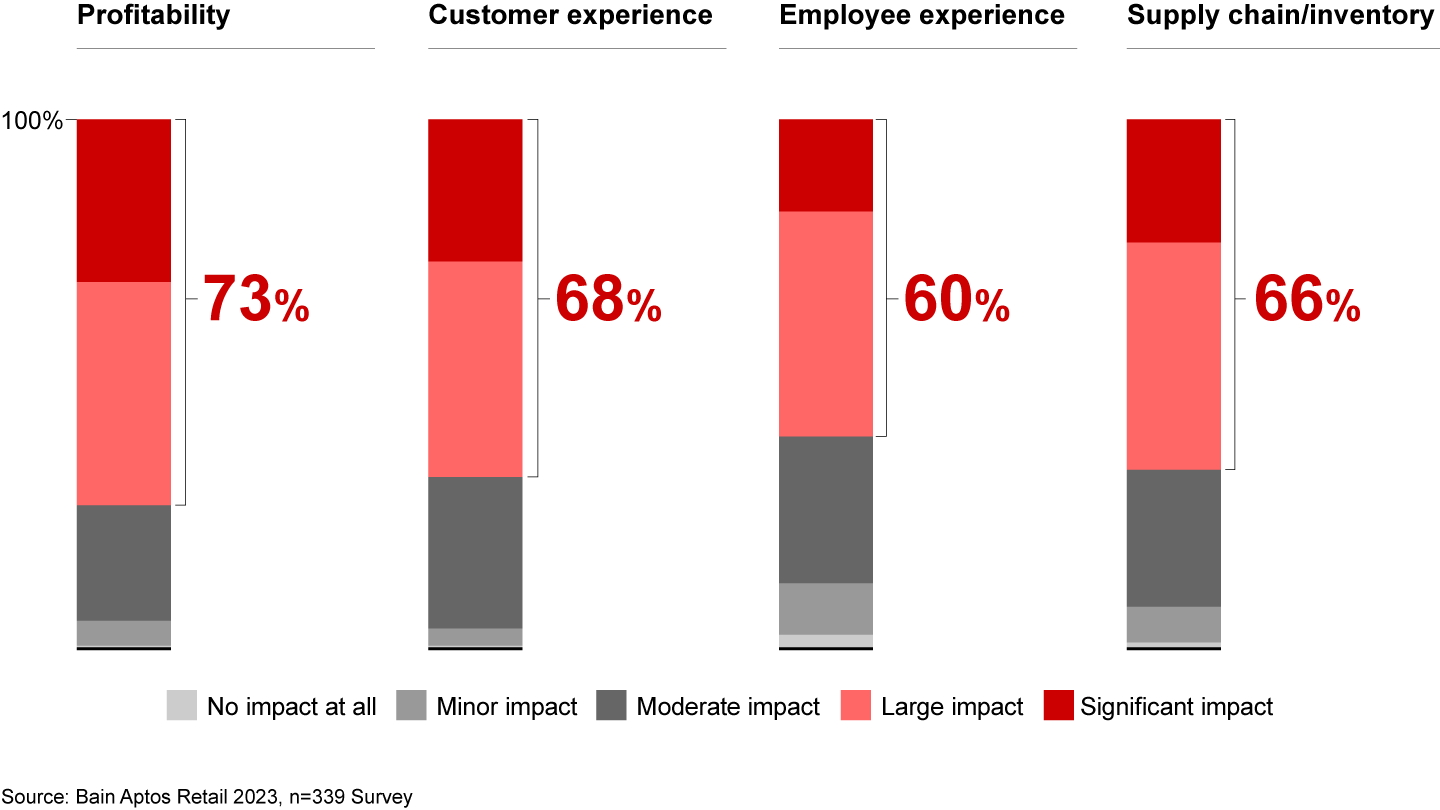
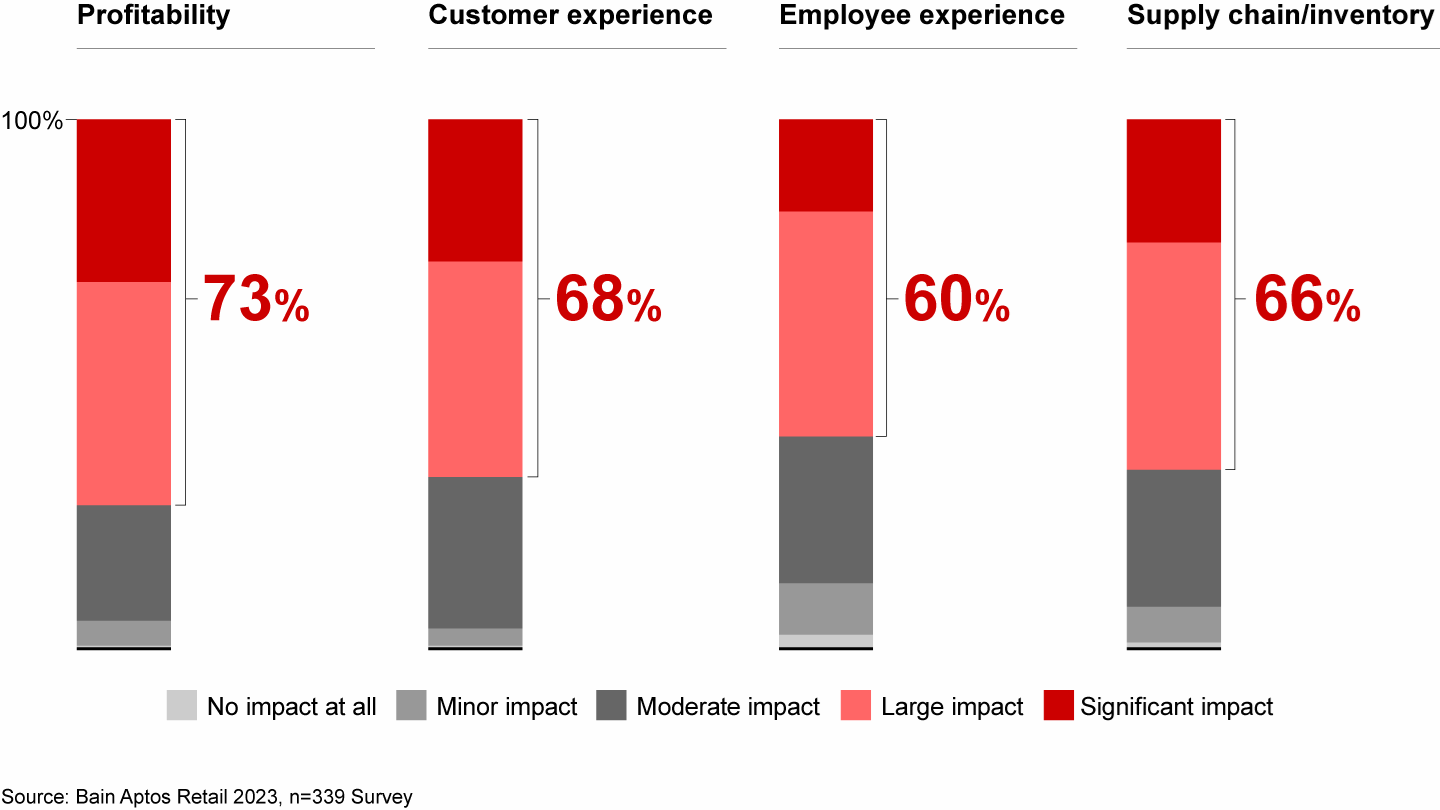
The building blocks of unified commerce
Our survey found that retailers believe the most important technologies for supporting unified commerce include inventory management, front-end e-commerce and store systems, and omnichannel order-management systems (see Figure 2). These technologies provide the connective glue between the various channels that customers interact with. For example, “buy online, pick up in store” (BOPIS) requires a unified view of inventory across physical stores (inventory-management systems) and an ability to provide flexible fulfilment (omnichannel order-management systems). Our survey results also found that executives place less emphasis on developing in-aisle selling tools for store associates—a missed opportunity, since our work finds that this tech is critical for enabling employees to assist customers during their shopping journey and provide a seamless customer experience. Connecting customers with staff who can help them along their purchase journey is one of the main benefits to shopping brick-and-mortar.
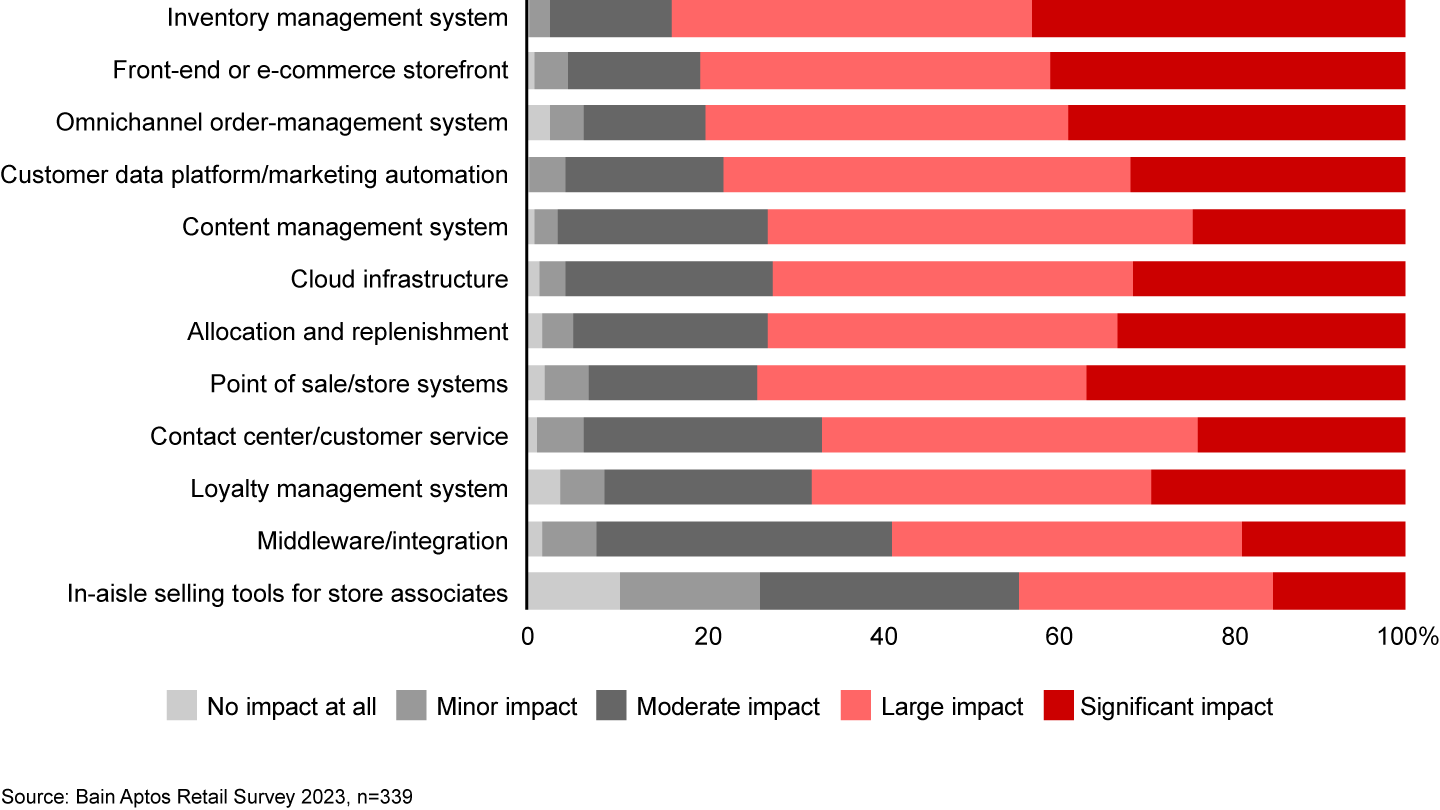
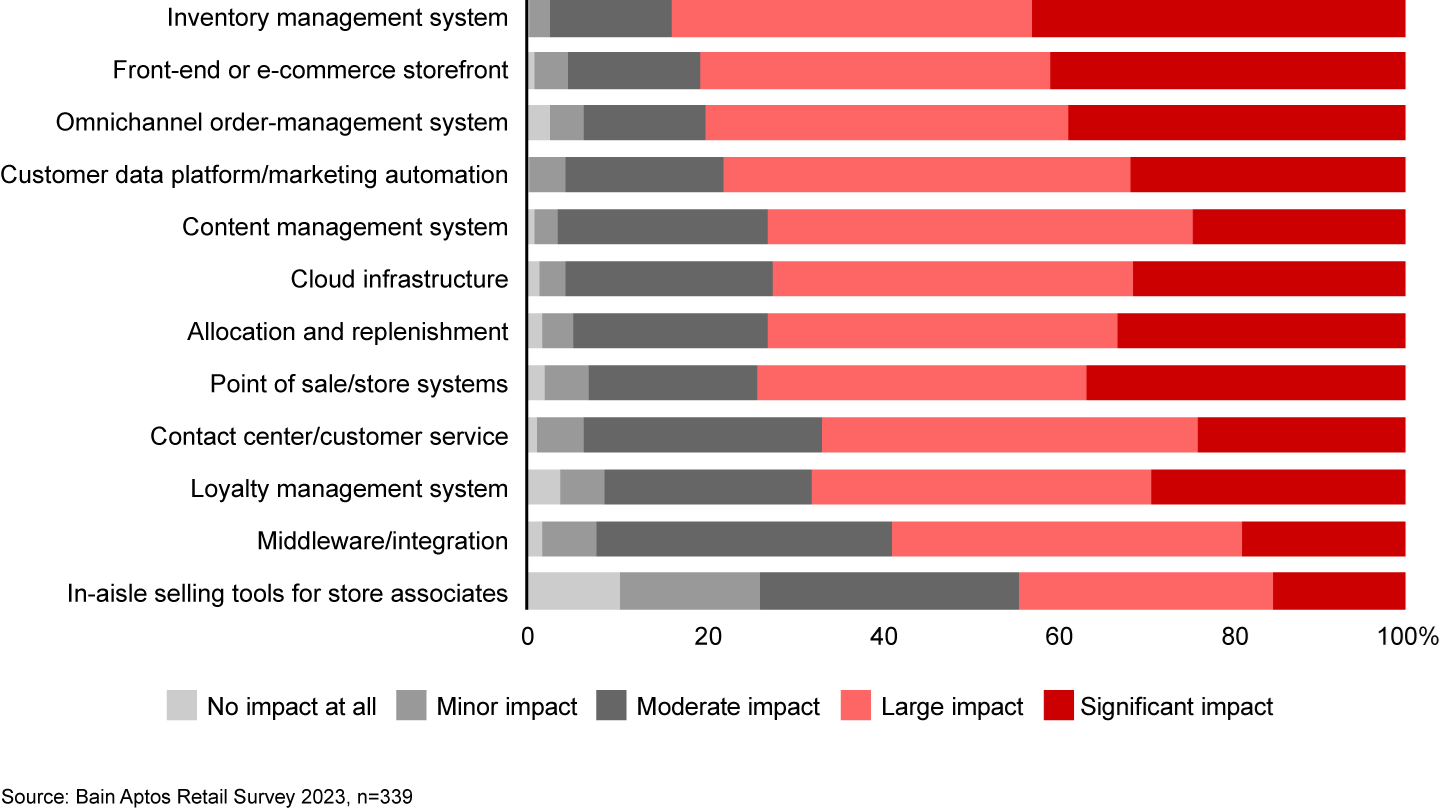
Retailers recognize that in-store technology is critical to success. More than 60% of retail executives said they have implemented in-store technologies that enable unified commerce use cases, such as allowing customers to buy or reserve online and pick up or return in stores (see Figure 3). Among the technologies they cited as contributing most to the in-store experience were point-of-sale technology (with 70% of executives attributing significant impact), inventory management (70%), and order-management solutions (65%). However, only 42% of respondents said they believe their physical stores are prepared to support unified commerce (see Figure 4). This represents a significant disconnect between the investments retailers are making and their ambition to deliver on unified commerce.
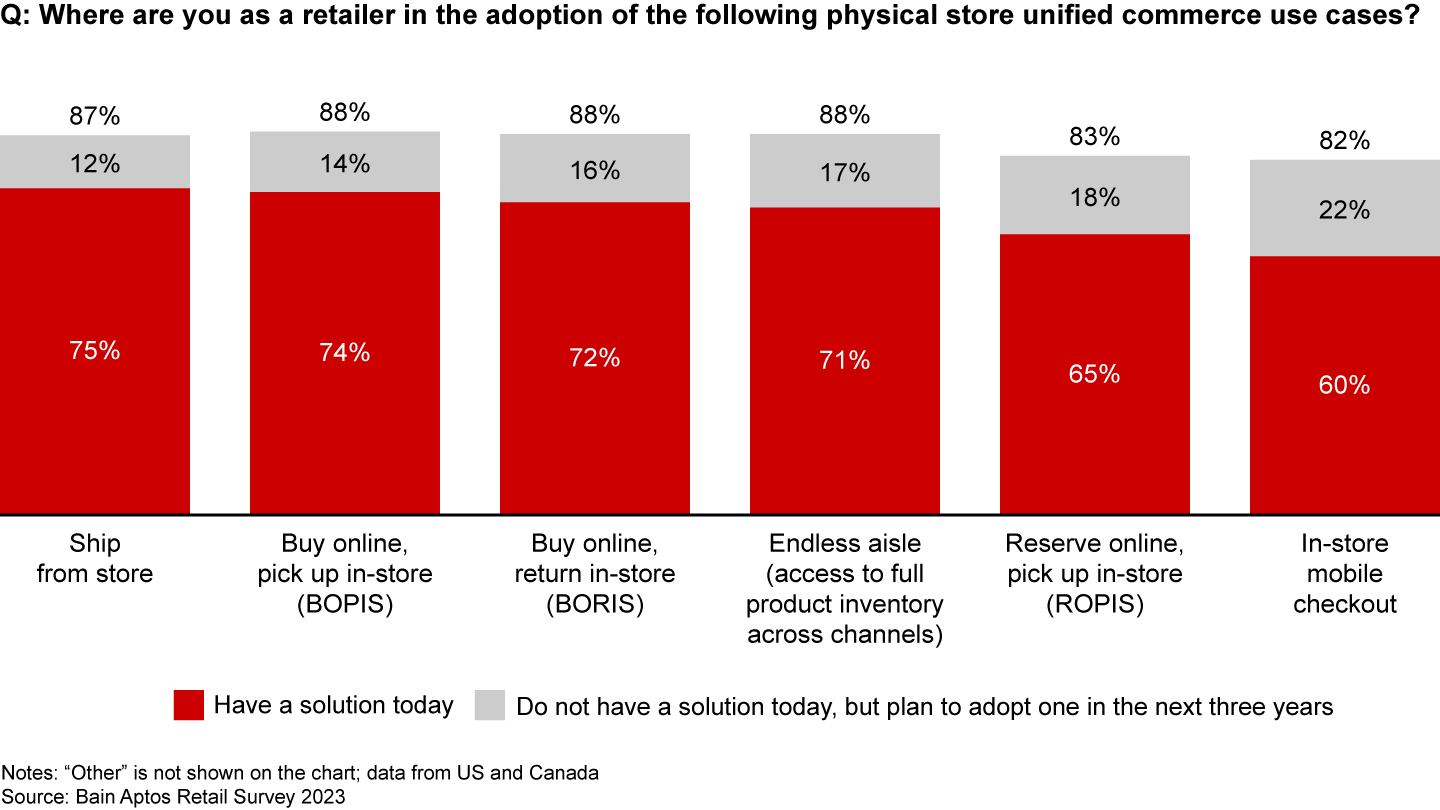
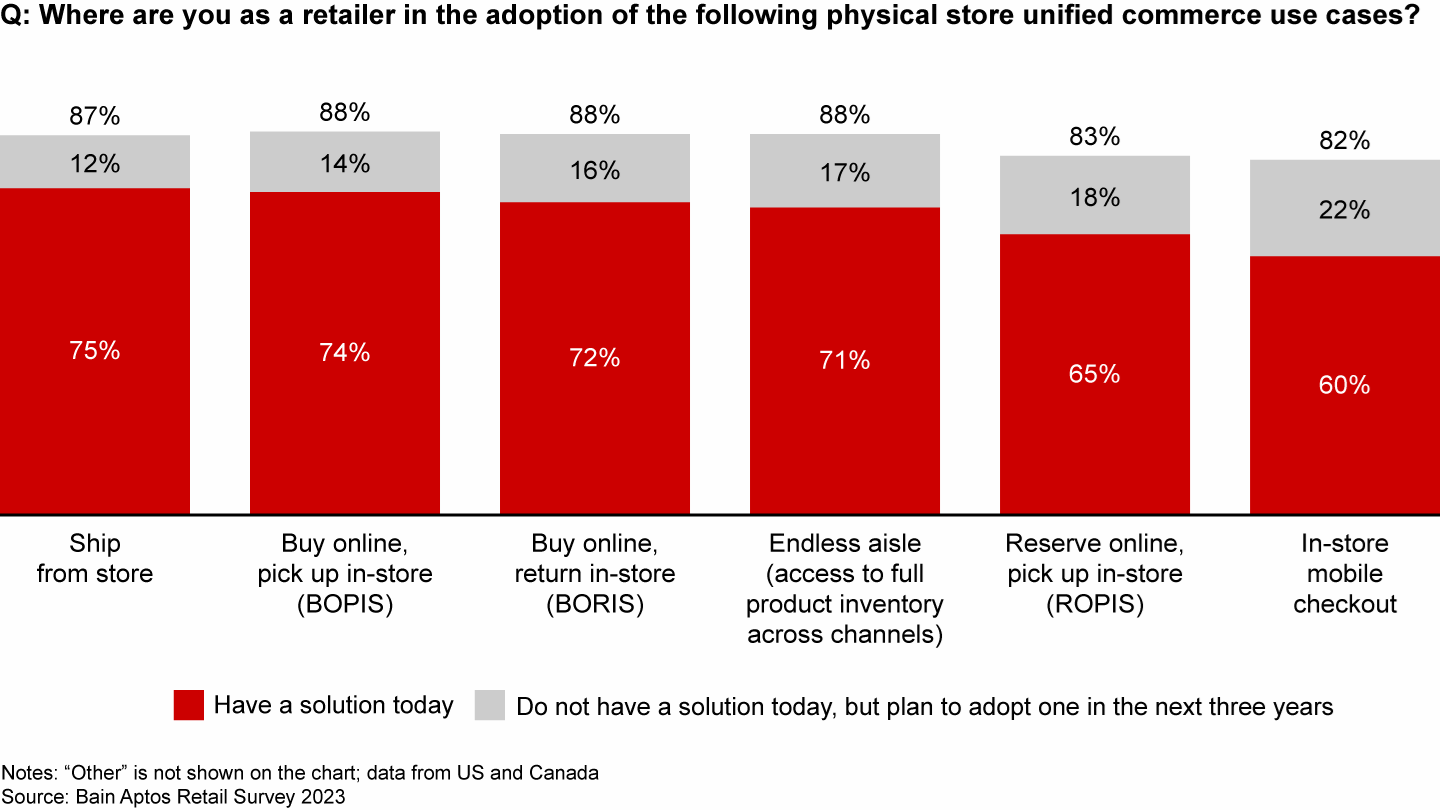
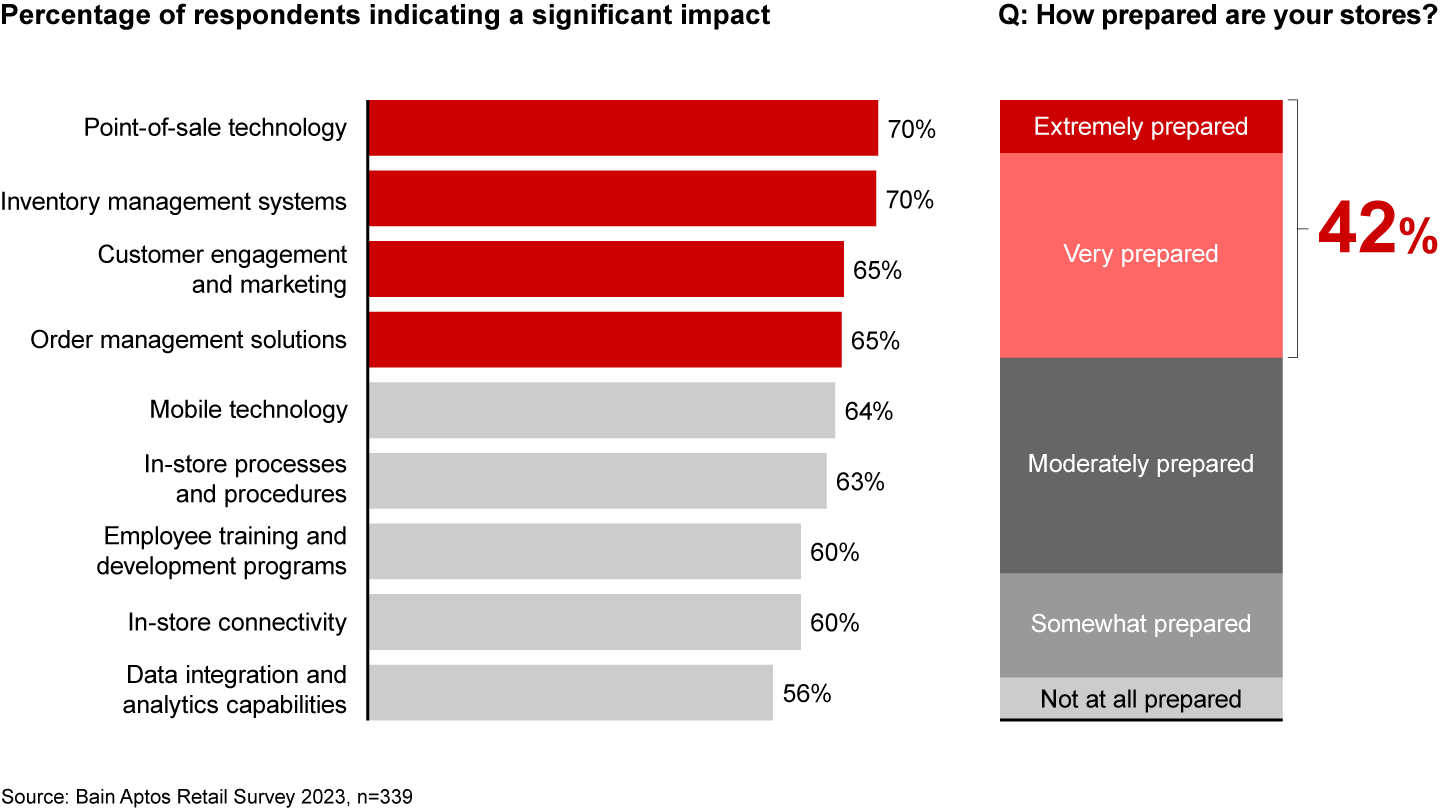
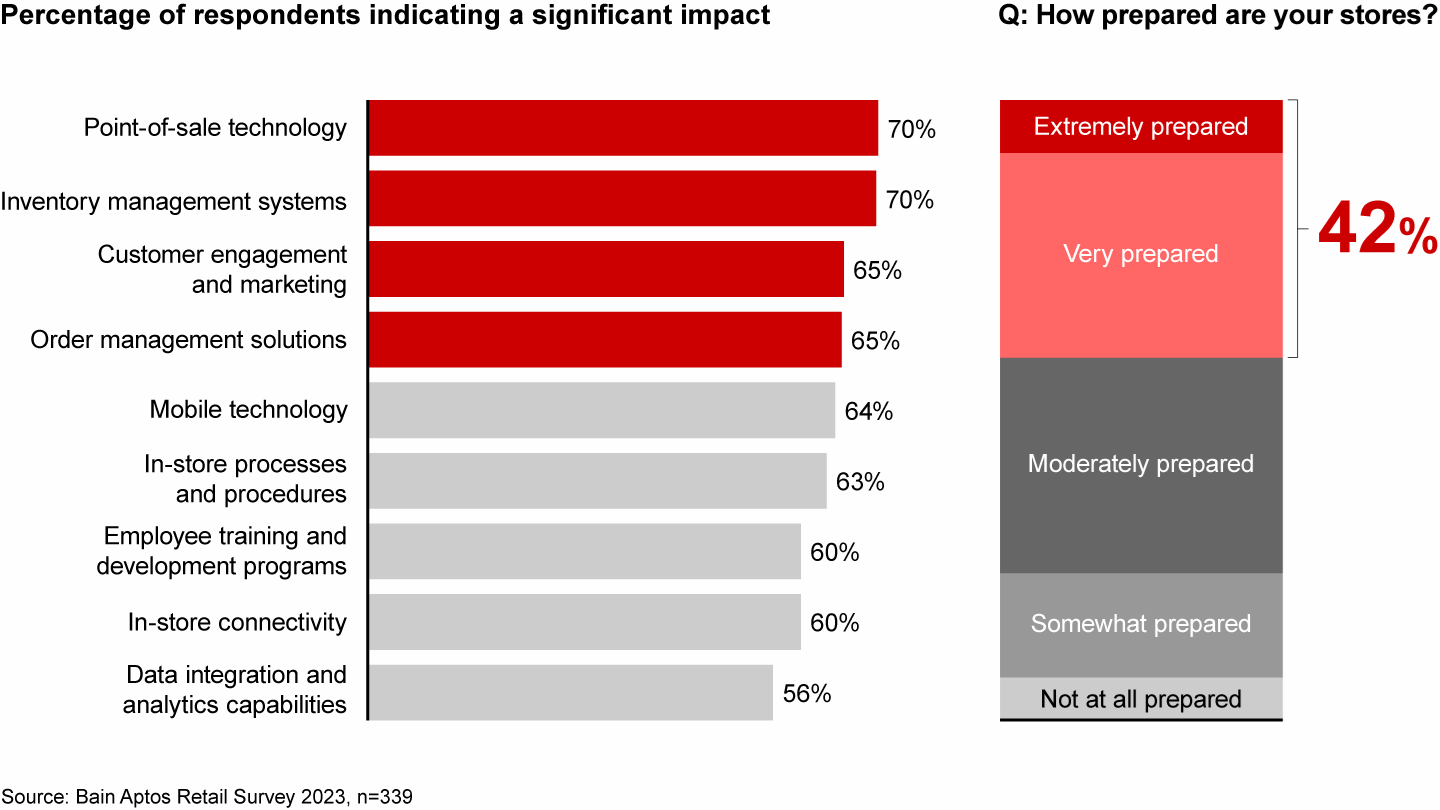
About 80% of retailers said they have invested in real-time inventory management and visibility, a figure that could grow to 90% within three years. These features include “available to promise” (ATP) inventory, which can reduce safety stock requirements and help retailers identify ways to sell overstocked inventories at better margins and with fewer touchpoints. Other top investments include mobile commerce and the integration of customer purchase history (online and in-store) through unified POS and CRM systems (see Figure 5).
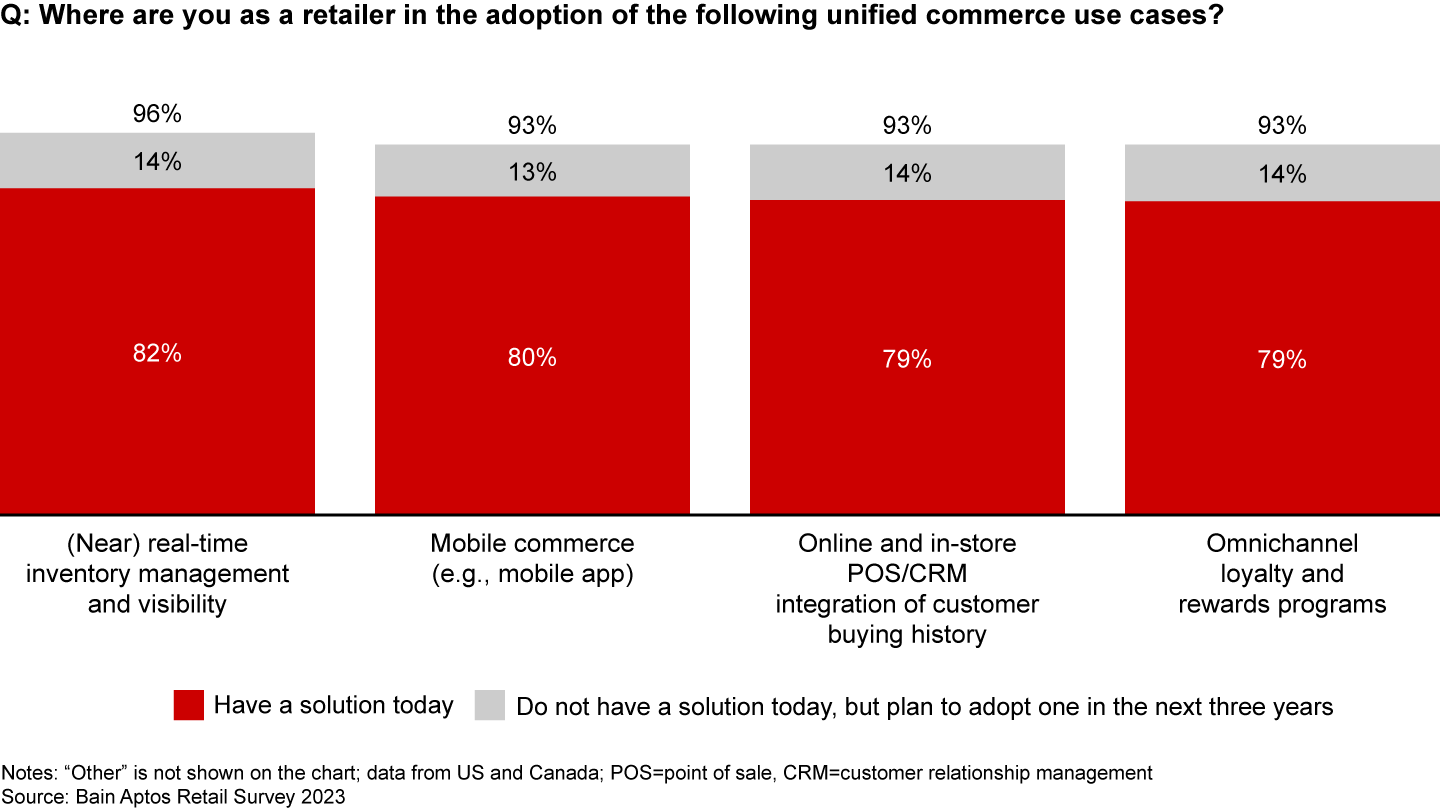
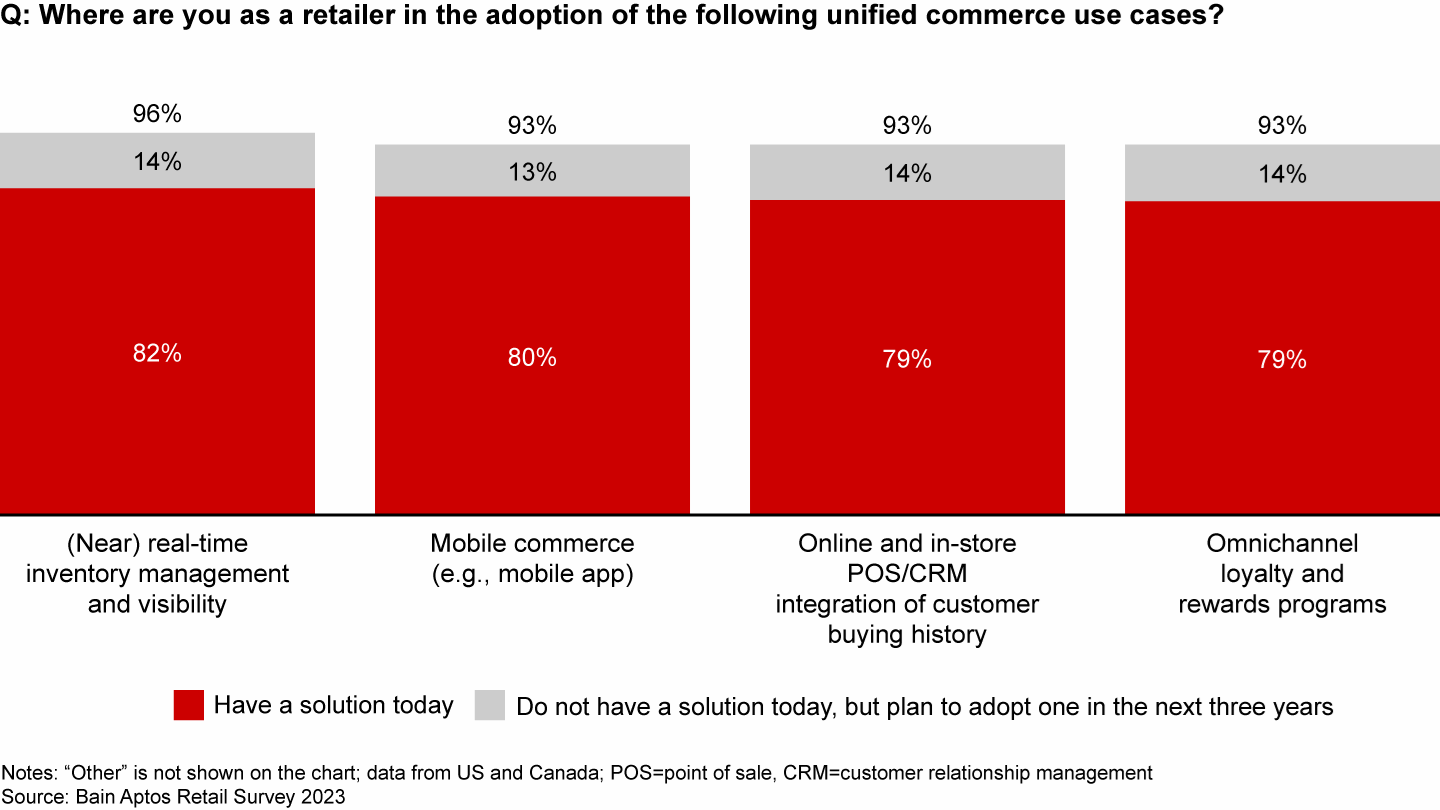
Our survey also found that 75% of retailers have ambitious unified commerce strategies, but only about 55% consider those strategies clear and well defined. Most retailers have instituted some unified commerce use cases, but only about 45% believe they have the tools and resources to execute on unified commerce, and only half of retailers believe their current technology is adequate to support their unified commerce ambitions.
Challenges to implementing unified commerce
Although most executives told us they understand the importance of these investments in technology, only about half are confident that their companies have a clear strategy to get the full value from those investments.
Many retailers are challenged by the burden of legacy systems that make interoperability and integration difficult. These legacy systems also lead to poor quality of data, which limits retailers’ abilities to provide the best experience to their customers. Retail leaders told us that they see investment in cloud infrastructure as critical to enabling unified commerce, not just through increased agility in IT but also through various SaaS offerings that allow them to focus on growing their business through sales and avoid being distracted by internal IT support headaches at their organizations.
Retail executives told us that the most important elements of success in developing a unified commerce platform were alignment between business and tech, collaboration across the organization, and overcoming the challenge of integrating new tech with legacy systems (see Figure 6).
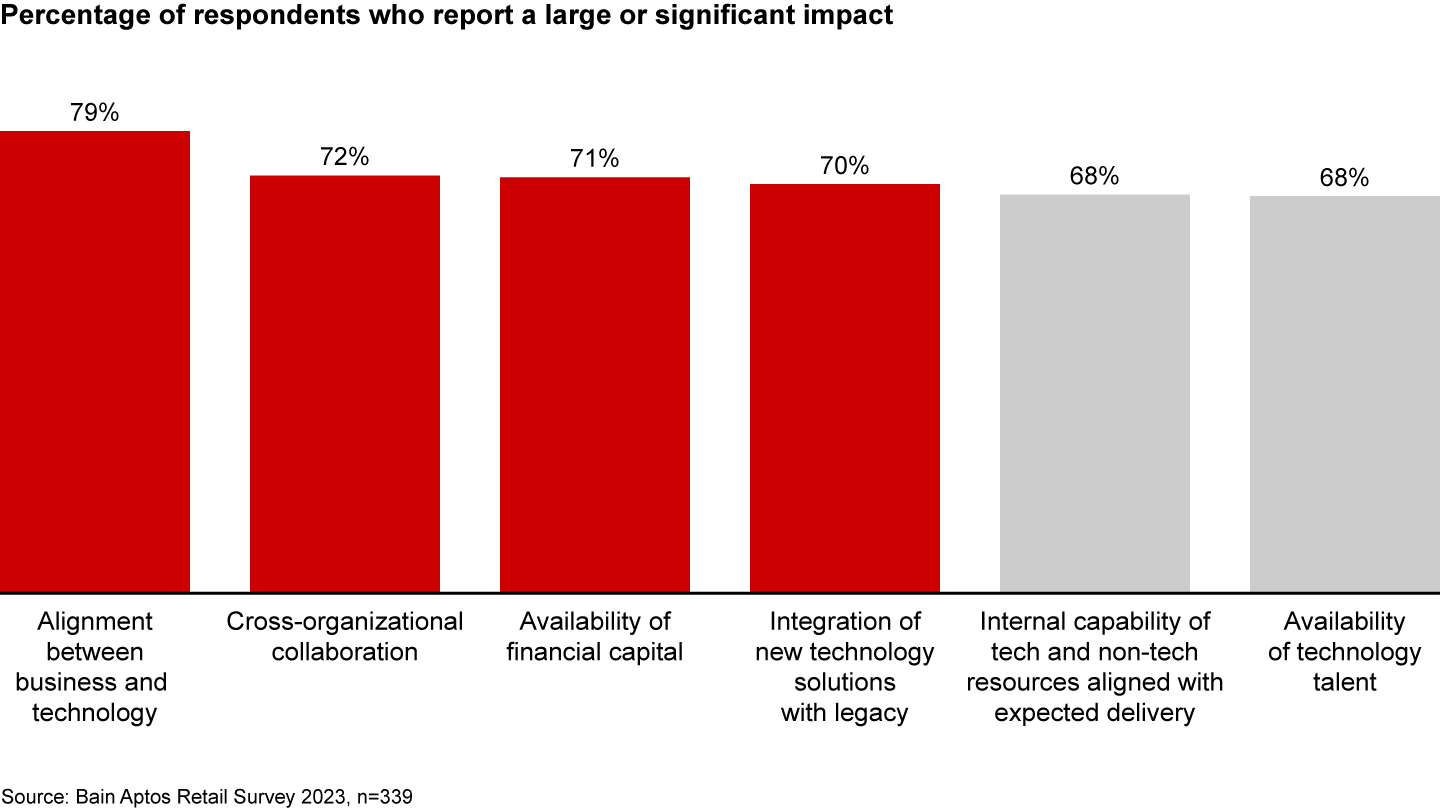
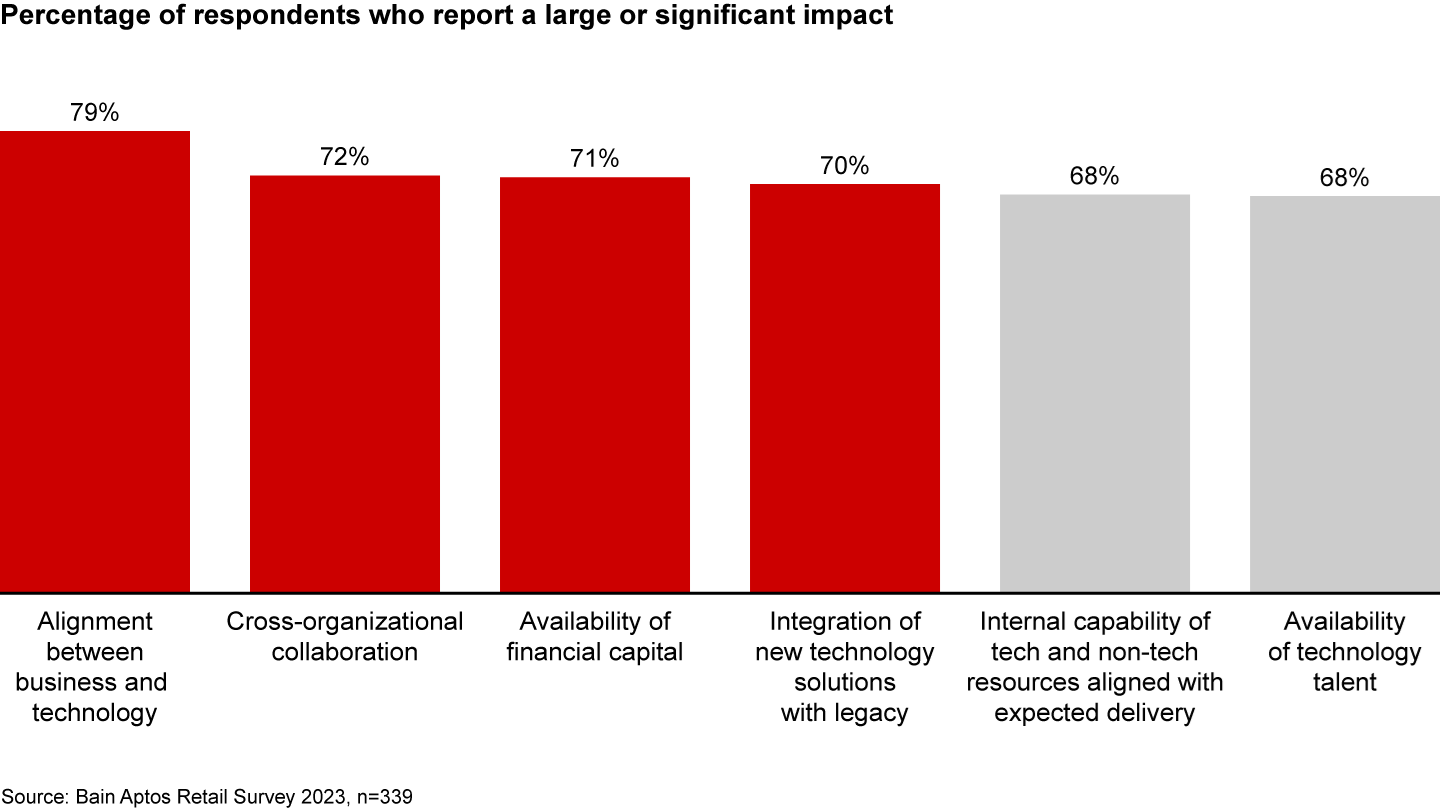
"Unified commerce is difficult to achieve because of existing legacy systems that you’ve previously invested in and now have to update. The more retail locations a company has, the more challenging it is."
Alignment and cross-functional collaboration show up as key enablers, and the range of decision makers is broad, including the CEO, CFO, COO, chief digital officer, chief technical officer, and leaders of e-commerce and merchandising. Success in retailing will increasingly depend on this diverse group of decision makers collaborating on delivery of unified commerce. And the data tells us that many of these executives are on different pages:
- C-level executives tend to have the highest ambitions, but in general they don’t believe they have the strategy, tools, and technology to achieve them.
- Senior executives reporting into the C-level are the most confident in reaching their unified commerce goals, and most believe they have the tools and technology to get there, while senior executives not reporting into the C-suite have significantly fewer ambitions around unified commerce and less confidence in their road to getting there.
- Leadership at lower levels share ambitious goals around unified commerce, meanwhile voicing the biggest gaps in the strategy, tools, and technology to realize them.
Retail executives believe that physical stores will continue to have a big impact as the omnichannel retail experience evolves. Many highlight the importance of providing an in-person component to customer experience and increasing conversion of customers.
Most retailers said they were likely to partner with a technology provider rather than try to develop their own tech; 85% of retailers are using some third-party solutions (the “buy” option) and half of retailers plan to use third-party solutions in the future. This compares to only 15% who plan to go with the “build” option—in-house solutions (see Figure 7). The most important criteria for deciding on third-party solutions are ease of integration with existing systems and processes (53% of executives attributed significant impact) and vendors being able to show total cost of ownership and a clear ROI of the solution (51%). Scalability (46%), reliability, and performance of the solution (43%), ease of use (38%), and ease of deployment (38%) also ranked high.
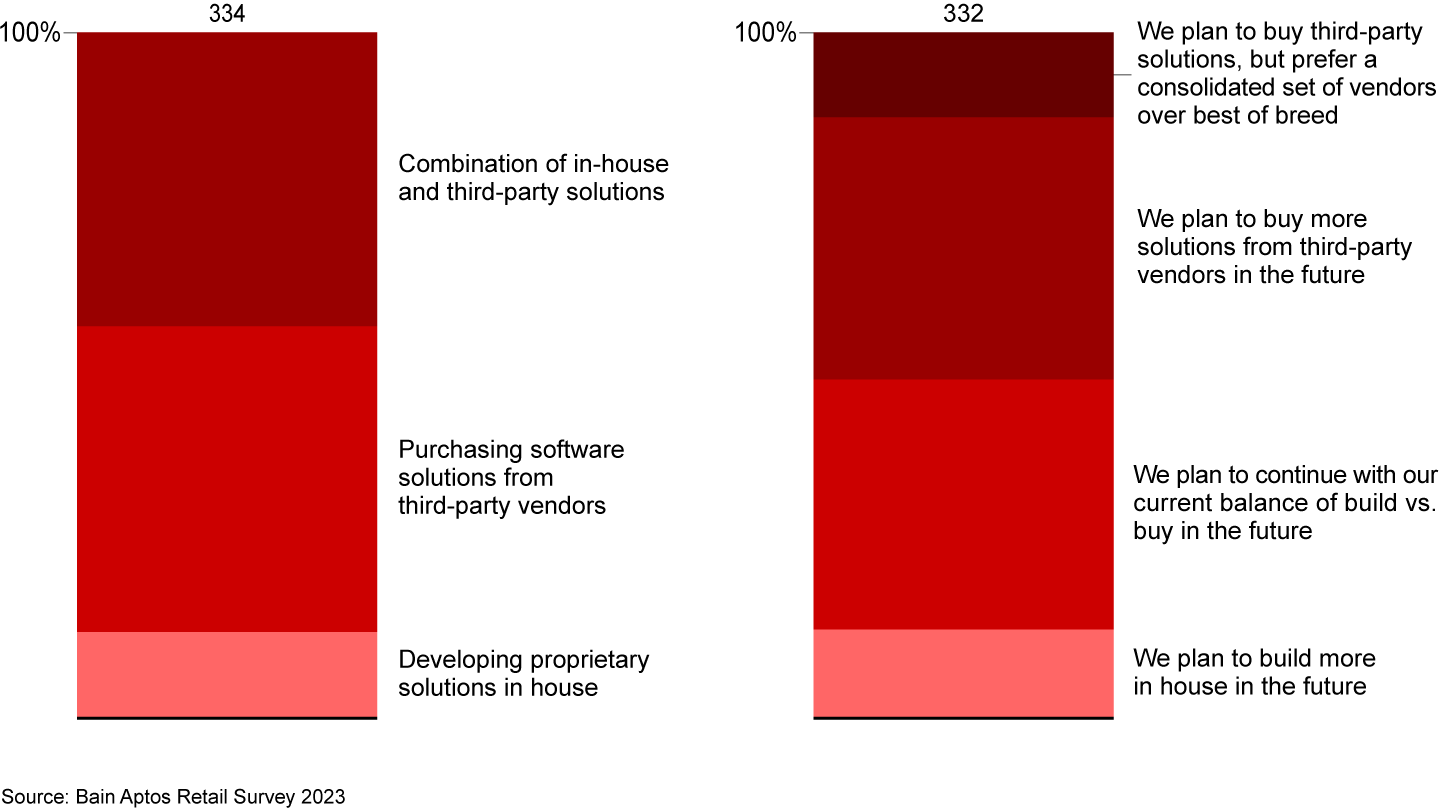
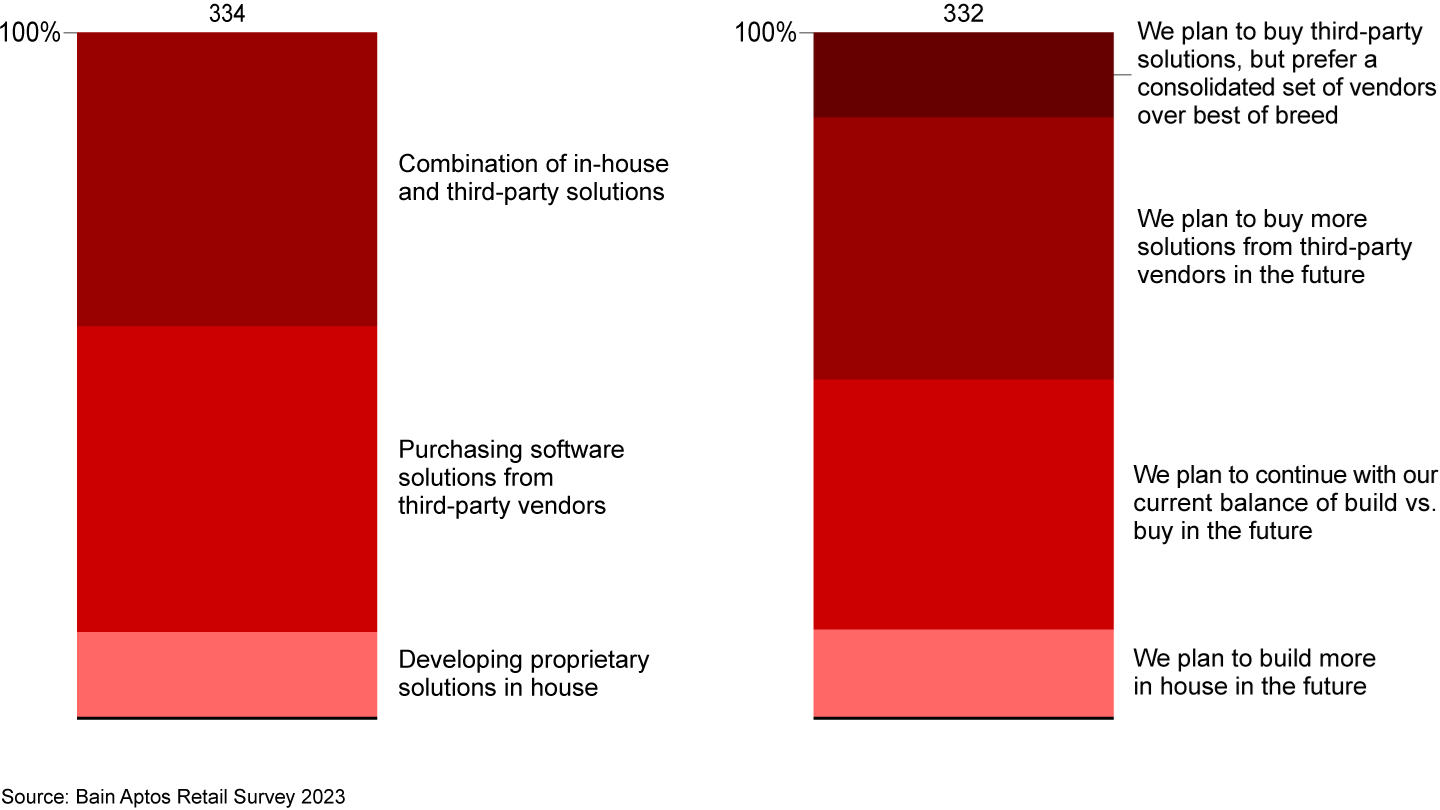
Unified commerce is still an emerging capability for many retailers, but it’s clearly a priority for most. Business leaders cannot ignore the technology and data requirements that drive unified commerce. Technology investments in inventory, e-commerce, and order management are critical, as are investments for the integration of mobile and in-store point-of-sale technology. Only by linking these systems can retailers develop the single view of customers so essential to unified commerce.
Retail executives see a wide range of financial and nonfinancial benefits, from pursuing unified commerce strategies, but the work to get there remains challenging. It is difficult not just because so many systems and their data have to come together, but also because people across the organization need to work together to get this right, from senior managers down to store associates. Companies who have done this have reaped significant benefits compared to their peers and are better positioned to react to future changes and see exponential growth.
To learn more about this research, please contact the authors.

About Aptos
Aptos is the global leader in unified commerce solutions for retailers. Aptos’ modern, cloud-native POS and advanced enterprise technologies are trusted by hundreds of retail brands around the world. For over 40 years, Aptos has delivered software solutions that help retailers inspire loyalty, maximize revenue and reduce costs.